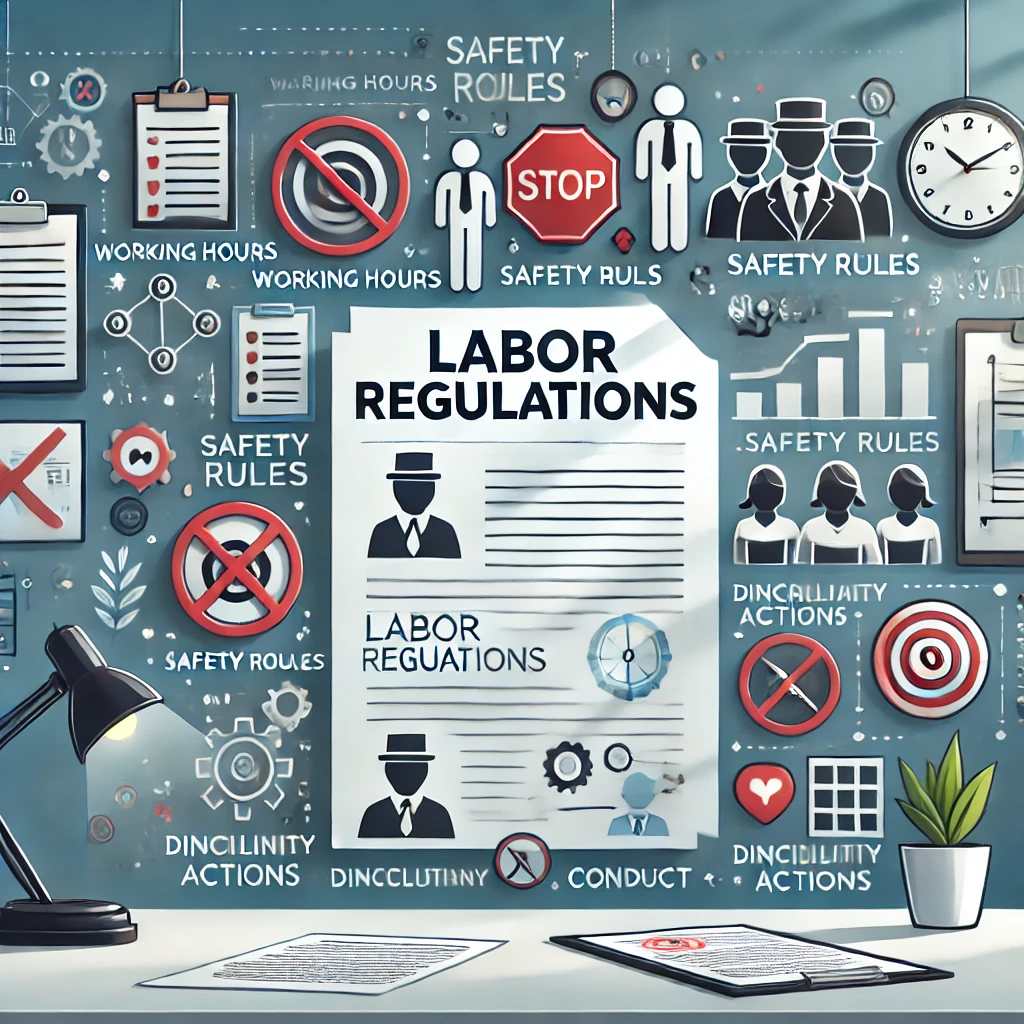Call us now:
What are Labor Regulations? Mandatory Contents of a Company’s Labor Regulations for Validity according to Vietnamese Law.

What are Labor Regulations?
Labor regulations are an important document issued by the employer, establishing rules, standards of behavior, responsibilities, rights, and obligations of employees during their work at the company. Labor regulations serve as a legal basis to govern the labor relationship between employees and employers, and as a foundation for handling disciplinary violations within the company.
For businesses with 10 or more employees, the employer is required to issue written labor regulations. After issuance, these regulations must be registered with the provincial labor authority to be legally effective.
For small businesses with fewer than 10 employees, issuing written labor regulations is not mandatory. However, this does not exempt the employer from setting labor rules. Instead of issuing written labor regulations, the employer must specifically agree on issues related to labor discipline and material responsibility within the labor contract. This ensures that both parties clearly understand and agree to the rules regarding discipline and responsibility during the employment process.
Contents of Labor Regulations
These regulations must comply with labor laws and other relevant legal provisions, and include the following key contents:
1/ Working Hours and Rest Periods
Working hours and rest periods are essential parts of the labor regulations, established to ensure the rights of employees while maintaining the company’s productivity and business efficiency.
The labor regulations must specify the regular working hours per day and per week, including the start and end times of each work shift, as well as shift work arrangements. Overtime rules must also be outlined, covering both regular and special circumstances. The regulations should detail break times, mid-shift breaks, shift changes, weekly rest days, annual leave, personal leave, unpaid leave, and the process for requesting leave.
2. Order in the Workplace
Order in the workplace is an essential part of the labor regulations, establishing the basic principles that employees must follow to maintain an efficient and professional work environment.
The regulations should specify the scope of work, rules for movement during working hours, and requirements for workplace behavior and attire. Employees must comply with the instructions, assignments, and directives of the employer to ensure work efficiency and discipline in the workplace.
3. Occupational Safety and Hygiene
The labor regulations must outline the responsibilities of employees in adhering to rules, procedures, and measures to ensure workplace safety and hygiene. These regulations should include fire prevention, the proper use and maintenance of personal protective equipment, and measures for cleanliness, decontamination, and disinfection at the workplace.
4. Prevention of Sexual Harassment in the Workplace
Employers must establish and enforce specific regulations for the prevention of sexual harassment in the workplace. This includes defining acts of sexual harassment, implementing preventive measures, and committing to protecting employees from any form of harassment.
Clear procedures must be set for handling sexual harassment incidents. These procedures should include steps such as receiving complaints, investigating the incident, and making disciplinary decisions against the offender. The actions must be prompt, serious, and ensure the rights of the victim, including protecting their identity and privacy.
5. Protection of Company Assets and Secrets
The regulations must clearly define the company’s key assets, important documents, technological secrets, business secrets, and intellectual property. This list may include equipment, machinery, software, customer data, product formulas, production processes, and other intellectual property.
Employees’ responsibilities for protecting company assets and maintaining confidentiality must be clearly outlined. Specific measures such as access restrictions, data encryption, and signing confidentiality agreements can also be implemented to ensure safety and security.
Clear definitions of violations, such as disclosing confidential information, unauthorized use of company assets or technology, and the corresponding disciplinary measures for these acts must be provided.
6. Temporary Reassignment of Employees
The employer has the right to temporarily reassign an employee to a different job than specified in the labor contract in cases where necessary due to production or business needs, such as sudden difficulties, natural disasters, fires, epidemics, or urgent business demands. The regulations must clearly outline the circumstances under which employees may be temporarily reassigned due to production or business requirements that differ from their labor contract.
7. Violations and Forms of Disciplinary Actions
The regulations should clearly define actions considered to be disciplinary violations, such as arriving late to work, being absent without a valid reason, failing to comply with safety regulations, or breaching confidentiality rules.
The regulations must specify appropriate disciplinary actions for each violation, which may include reprimands, wage increase deferrals, demotions, or dismissal, depending on the severity of the violation.
8. Material Responsibility
The regulations must clearly define the cases where employees are required to compensate for damages, such as damaging tools or equipment, causing harm to the company’s property, losing tools, equipment, or assets, and consuming materials beyond the allowed limits.
The compensation amount should be specifically calculated in accordance with the extent of the damage caused. The regulations must clearly outline how compensation is calculated to ensure fairness and reasonableness for both the employee and the employer.
The individual with the authority to make decisions and handle compensation for damages must be clearly identified, typically the person authorized to sign labor contracts or a person specified in the labor regulations.
9. Authorized Person for Disciplinary Action
The labor regulations must specify who has the authority to enforce disciplinary actions, usually the person authorized to sign labor contracts or someone specifically designated in the labor regulations.
Contact Us Now:
DCNH LAW
Address: 38B Tran Nhat Duat, Phuoc Hoa ward, Nha Trang city, Khanh Hoa province, Vietnam.
Phone: (+84) 343320223 – 974278893
Email: dcnh.law@gmail.com




